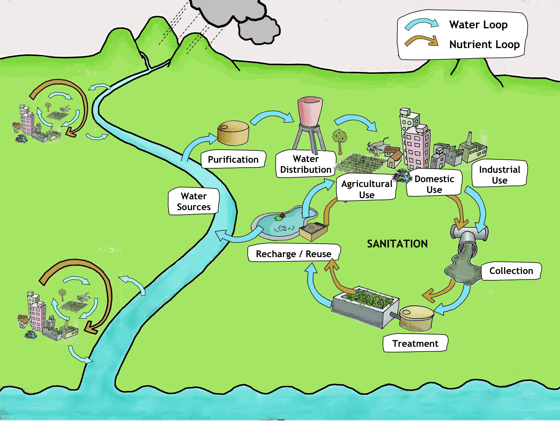
The Sustainable Sanitation and Water Management Loop. Source: SEECON (2010)
(CLICK ON THE BOXES TO GET DIRECTLY TO THE RESPECTIVE AREA)
With WHAT kind of solutions can I optimise my local water management and sanitation system and make it more sustainable?
This section should give you concrete ideas on this question. It contains both technical (Hardware) as well as economic, political and social instruments (Software).
Seven overarching themes include a large number of different tools to:
Water Sources Management
Water Purification
Water Distribution
Water and Nutrient Use
Wastewater Collection
Wastewater Treatment
Reuse and Recharge of Nutrients and Water
These themes represent an ideal water and sanitation management system. It puts humans and their influence on the water and nutrients at the centre, yet proposes a loop-based system, which is sustainable and durable.
Your local water and sanitation system might look a bit different and some parts might be even missing in your case. Yet, the different software and hardware tools will give you an idea on what kind of solutions have been successfully implemented in various parts of the world to make local sanitation and water management systems more sustainable, to reduce the use of water or to efficiently recycle the generated wastewater and nutrients. Not all tools will work in your specific case and you will have to assess which ones could be the most promising in your case. The understand your system section will help you to identify problems, root causes and interdependencies. Complete this exercise first, before choosing solutions!
What is meant by "Software" and "Hardware" Implementation tools?
Hardware Tools
"Hardwares" are technical options to optimise your water and nutrient cycle. These are physical solutions that you can see and touch with your hands such as water filters, toilets, treatment systems or technologies to recycle water and nutrients. Usually, you will nee a combination of different hardware and software tools to really make a sustainable impact.
Software Tools
"Softwares", on the other hand, are instruments and set-ups with aim to change the behaviour and attitudes of different actors to optimise the sanitation and water management system. Software tools can also be implemented without combining them with hardware tools.
However, software tools are a bit "fuzzy", as one cannot really see or touch them. The software tools are divided into four different groups:
- With Tools to Create an Enabling Environment you take care of a sound framework for sustainable sanitation and water management. A functioning enabling environment is the precondition for the implementation any other software or hardware tools. Certain basics such as a legal or institutional framework, sound enforcement bodies and human skills need to be developed before you can implement any other measures.
- With Awareness Raising Tools, you try to influence social norms, attitudes and values of people so they will change their behaviour because they are convinced that they are doing the right thing and their actions are in line with their personal values. Different types of information, education and communication (IEC) instruments can be used to initiate behavioural change and to stimulate social pressure towards sound and sustainable policies.
- Command and Control Tools are direct regulations of requirements, bans and rules. With command and control tools, you only change the behaviour of people because they want to avoid penalties for non-compliance. People don't necessarily also change their values; that is also the reason why command and control tools only work when they can really be enforced, and when those who do not comply are actually charged.
- With Economic Tools, people change their behaviour because they want to achieve maximal benefit at minimal cost. Economic Tools involve the use of prices and other market-based instruments to provide incentives monetary incentives to change behaviour.
How to achieve evidence-based behavioural change
Providing target populations in developing countries with hygiene, sanitation and water “hardware” must be accompanied by so-called “software” programmes to achieve behavioural change. As behaviour is the product of psychological processes, public awareness campaigns must be conducted to change the factors influencing the outcome of these processes. It is thus necessary to determine the key factors responsible for changing a behaviour, and to implement behavioural change techniques that most effectively change these factors.
MOSLER, H. ; HUBER, A. ; INAUEN, J. ; TOBIAS, R. (2012): How to achieve evidence-based behavioural change. Entradas: Sandec News: Volume 13 URL [Visita: 01.12.2015]